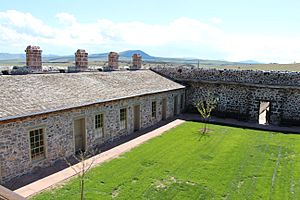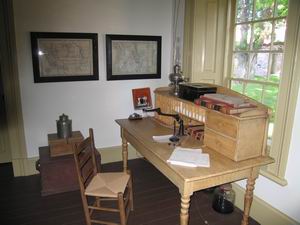Cove Fort facts for kids
Quick facts for kids |
|
|
Cove Fort
|
|

Front View
|
|
| Location | Millard County, Utah, United States |
|---|---|
| Built | 1867 |
| NRHP reference No. | 70000623 |
Cove Fort is a historic fort and community located in Millard County, Utah. It was built in 1867 by Ira Hinckley at the request of Brigham Young. What makes Cove Fort special is that its walls are made from strong volcanic rock. Many other forts from the mid-1800s in the American Old West were built with wood. Because of its sturdy rock construction, Cove Fort is one of the few forts from that time that is still standing today.
Even though Cove Fort is a historical site with no people living there permanently, it's famous for being the western end of Interstate 70. You might even see "Cove Fort" listed on freeway signs as a major destination!
Contents
The Story of Cove Fort
Brigham Young chose the spot for Cove Fort because it was perfectly halfway between Fillmore, Utah (which used to be the capital of the Utah Territory) and Beaver, Utah. This made it a perfect stopping point, or "way station," for people traveling along the Mormon Road. People could rest and get supplies here.
A town was planned for the area, but there wasn't enough water to support many people. Before Cove Fort was built, there was a wooden fort called Willden Fort nearby. This older fort gave shelter to the workers who built the new, stronger Cove Fort.
Building a Stronghold
Cove Fort is a square, 100 feet (about 30 meters) on each side. Its strong walls are made from black volcanic rock and dark limestone. These rocks were dug up from the mountains nearby. The walls are 18 feet (about 5.5 meters) high and 4 feet (about 1.2 meters) thick at the bottom. They get a bit thinner at the top, about 2 feet (0.6 meters) thick.
The fort has two big wooden doors on its east and west sides. These doors were originally filled with sand to help stop arrows and bullets. Inside, there are 12 rooms, six along the north wall and six along the south wall.
A Busy Travel Stop
For many years, Cove Fort was a very busy place. It was a daily stop for two different stagecoach lines, plus many other travelers. Sometimes, up to 75 people would stay and eat there at once!
Besides offering a place to rest, the fort had a blacksmith and farrier. This person would put new shoes on horses and oxen. They also fixed wagon wheels for travelers. Cove Fort was also an important communication center. It had a telegraph office and was a stop for the Pony Express.
Bringing Cove Fort Back to Life
In the early 1890s, The Church of Jesus Christ of Latter-day Saints decided the fort was no longer needed. They rented it out to different people. Eventually, in 1911, they sold it to W.H. Kesler. By 1903, when Kesler first visited, a fire had damaged the north side rooms, and parts of the fort were falling apart.
The Keslers rented the fort and moved in with their family in 1904. They slowly fixed it up, grew crops like alfalfa, and planted fruit trees. They rebuilt the damaged north side rooms in 1917.
A Historic Site for Everyone
In 1988, the Hinckley family bought the fort and gave it back to The Church of Jesus Christ of Latter-day Saints. The Church then carefully restored the fort to look like it did in the past. They even moved Ira Hinckley's old cabin from Coalville, Utah to the site.
Today, Cove Fort has a visitor center and is open as a historic site. You can take free guided tours every day, usually starting around 8 AM and ending about 30 minutes before sunset.
Cove Fort and Highways

The first major road to pass by Cove Fort was the Arrowhead Trail. This road connected Salt Lake City with Los Angeles. Later, this route became U.S. Route 91, and today it is part of Interstate 15.
When the Interstate Highway System was being planned, people realized there wasn't a direct freeway connecting the central United States to southern California. To fix this, a new freeway, Interstate 70, was built west from Green River, Utah, towards Cove Fort. This route used to be very hard to travel on paved roads. Since then, Cove Fort has been known as the western end of Interstate 70.
The Famous Baltimore Sign
In 2004, the Federal Highway Administration was testing a new type of writing for road signs called Clearview. This font was designed to be easier to read at night. One test sign was put up in Baltimore, Maryland, which is the eastern end of Interstate 70. This sign listed Cove Fort as a destination, showing it was 2,200 miles (about 3,540 kilometers) away!
Many people became curious about Cove Fort because of this sign. An employee said that the number of questions they got about Cove Fort proved the test was a success. The sign became so popular that after the test, it was decided to keep it there permanently. This sign even led to many stories about Cove Fort being published in the Baltimore area. Some people in both Utah and Maryland have even suggested putting a similar sign at Cove Fort, showing the distance to Baltimore!
Other Historic Forts
- Fort Deseret, another fort listed on the National Register of Historic Places.
- Moyle House and Indian Tower, another fort also listed on the National Register of Historic Places.





